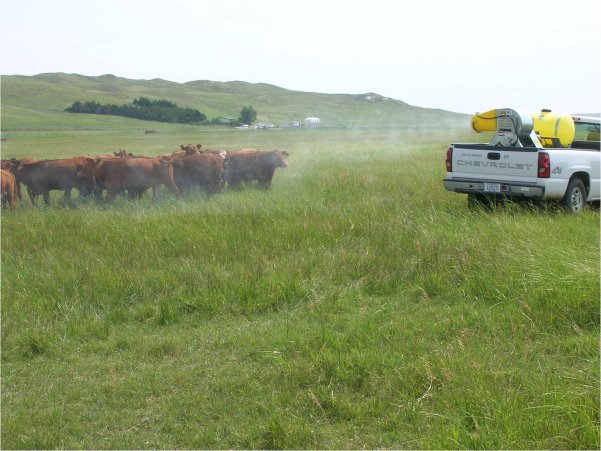
By Bethany Johnston, UNL Extension Educator
Horn and stable flies are common pests. The warm weather will cause flies to hatch early, so now is the time to start thinking about control. Controlling flies before they are a problem (early in the season) will give you the biggest bang for your buck. Dave Boxler, UNL Extension, has been conducting research for over 20 years, and has suggestions for these beef pests.
Horn flies were brought over from Europe hundreds of years ago and spend their entire life on cattle except to lay eggs in fresh manure. Horn flies can impact weaning weights in calves, due to the vast amount of blood lost to flies from the nursing cow, ultimately causing lower milk production.
Horn Fly Control: Control of horn flies includes feed additives to kill eggs in manure, dust bags, pour-ons, back rubs, mist sprayers, and most common - ear tags. Control products recommended as animal sprays are: coumaphos (Co-Ral), permethrin (many brand names), natural pyrethrins, and phosmet (Prolate).
When using insecticide tags for horn flies, two tags per adult animal should be in place about June 1st (during a normal year) or when fly populations are over 200 flies per animal. About 60 flies can fit into the size of a silver dollar (you can see pictures at http://beef.unl.edu). The tags release a great amount of chemical early and then taper off. Tagging too early will cause the greatest amount of chemical to be released from the tags before the flies become a problem. Applying insecticide ear tags in early May will most likely require re-application of ear tags or switching to an alternative fly control method later in the summer to achieve season-long fly control. All adult animals should be tagged in the herd. Remove old tags to prevent chemical resistance in the flies. If your tags aren’t working, you may have to switch methods and the type of chemical used. Another problem with horn flies is they can travel distances up to 15 miles. You may able to quell the fly population in your herd, only to have horn flies migrate in from another area, or from neighboring cattle herds.
Stable flies are the major cause of bunching in cattle. The stable fly originated from Africa and has a rough, jagged mouthpart that tears the flesh and causes great pain in the animal. Only three stable flies per leg can cause cattle to bunch, stomp their legs, or stand in the waterholes. Stable flies develop in rotting organic material like decaying manure, grass clippings, or wet rotting silage. Since most barns contain hospitable environment for stable fly eggs, stable flies are found around barns/stables, as well as feedlots and compost piles. However, open pastures in the Sandhills usually lack the organic decaying material needed for stable fly eggs. How do stable flies end up in pastures? Stable flies can travel up to 50 miles by themselves, hitch a ride on the sides of trailers, or may migrate on weather fronts. Since the stable flies feed on blood, they tend to congregate on the legs where the veins and blood vessels are close to the skin. Feeding stable flies are very painful and disrupt grazing and lead to lower weight gains.
Stable Fly Control: Since dust bags and oilers don’t deliver pesticide to the legs, they are inefficient, as well as ear tags. The only management option available for control of stable flies on range cattle is the use of animal sprays. Products such as coumaphos (Co-Ral), permethrin (many brand names), natural pyrethins (many brand names), and phosmet (Prolate) are available for use. Clean-up of wasted feed at winter feeding sites may prevent localized fly development but may not reduce the economic impact of stable fly feeding. Animal sprays work well, but are labor intensive and require gathering and penning of animals which might not be practical in large pasture situations. Mist blower sprayers work rather well, some ranchers with large pastures have mounted misters on their cake pickups: the cows are caked and then misted with fly spray as they eat.
More information on the control of flies can be found at the UNL Beef Website at http://beef.unl.edu or Dave Boxler at 308.696.6721. Stable Fly Control on Cattle (NebGuide G1152) covers control of this pest in more detail (http://www.ianrpubs.unl.edu/sendIt/g1152.pdf).